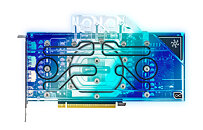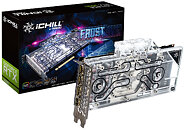Monday, November 9th 2020

INNO3D Announces iChill GeForce RTX 30-series Frostbite Liquid Cooled Graphics Cards
INNO3D, a leading manufacturer of pioneering high-end multimedia components and innovations brings you the new INNO3D GeForce RTX 3090 / 3080 iCHILL Frostbite. Following the huge success of its predecessor iCHILL Frostbite from the previous generation RTX 20 Series, we have now also armed our powerhouse RTX 3090 / 3080 graphics cards with an updated version of the iCHILL Frostbite.
Founded in 1998 with the vision of developing pioneering computer hardware products on a global scale. Fast forward to the present day, INNO3D is now well-established in the gaming community known for our innovative and daring approach to design and technology. We are Brutal by Nature in everything we do and are 201% committed to you for the best gaming experience in the world.The new NVIDIA GeForce RTX 30 Series GPUs, the 2nd generation of RTX, features new RT Cores, Tensor Cores and streaming multiprocessors, bringing stunning visuals, amazingly fast frame rates, and AI acceleration to games and creative applications. Powered by the NVIDIA Ampere architecture, which delivers increases of up to 1.9X performance-per-watt over the previous generation, the RTX 30 Series effortlessly powers graphics experiences at all resolutions, even up to 8K at the top end. The GeForce RTX 3090, 3080 and 3070 represents the greatest GPU generational leap in the history of NVIDIA.
Our Water Block Is Back
Due to popular demand the iCHILL Frostbite made its way into the iCHILL line-up once again and paired with our powerful RTX 3090 / 3080 GPUs that guarantee you the ultimate gaming experience. High quality components combined with style and amazing RGB lighting is what sums up the iCHILL Frostbite, but the development of this graphics card water block design further increased the performance as well.
The components were repositioned so that they sit closer to each other by reducing the thermal pads to a thickness of just 1mm. The thickness of the nickel-plate copper block was also reduced down to 5.5mm thick. The water flow inside the cooler has also been optimised from previous RTX 20 series models. The base of the iCHILL Frostbite is built with pure copper and is nickel plated which completely seals the heatsink protecting it. All important components such as the voltage transformers and the memory are now significantly better and more effectively cooled by the water. All this ensures a significant increase in cooling performance. A range of around 60 - 65 °C can be achieved when using a 240 mm or 360 mm radiator.
Same But Different
We try to balance innovation with continuous development of new products with products that we have mastered but still improve for the next generation GPUs. Whether it is on the technology and/or the design, there is always something to look forward to when we update a design from previous generation models. With the RTX 30 series iCHILL Frostbite we have managed get the water block to perform at levels which can handle todays' most demanding gaming titles. The design speaks for itself, transparent, bold and striking which aligns with our new radical approach to design for the new RTX 30 series and to become as Brutal by Nature as ever.
Years of R&D has allowed INNO3D to make technological advancements, continously pushing the boundaries and bolster their expertise in the GPU industry. It has elevated INNO3D to a point that makes a difference for high-end gamers and design creation professionals achieving high performance with outstanding temperature control and at super quiet noise levels.
INNO3D is now working hard to make the new INNO3D GeForce RTX 3090 / 3080 iCHILL Frostbite GPUs available at all premium resellers across the region.
For more information, visit the product pages of the RTX 3090 iChill Frostbite and RTX 3080 iChill Frostbite.
Founded in 1998 with the vision of developing pioneering computer hardware products on a global scale. Fast forward to the present day, INNO3D is now well-established in the gaming community known for our innovative and daring approach to design and technology. We are Brutal by Nature in everything we do and are 201% committed to you for the best gaming experience in the world.The new NVIDIA GeForce RTX 30 Series GPUs, the 2nd generation of RTX, features new RT Cores, Tensor Cores and streaming multiprocessors, bringing stunning visuals, amazingly fast frame rates, and AI acceleration to games and creative applications. Powered by the NVIDIA Ampere architecture, which delivers increases of up to 1.9X performance-per-watt over the previous generation, the RTX 30 Series effortlessly powers graphics experiences at all resolutions, even up to 8K at the top end. The GeForce RTX 3090, 3080 and 3070 represents the greatest GPU generational leap in the history of NVIDIA.
Our Water Block Is Back
Due to popular demand the iCHILL Frostbite made its way into the iCHILL line-up once again and paired with our powerful RTX 3090 / 3080 GPUs that guarantee you the ultimate gaming experience. High quality components combined with style and amazing RGB lighting is what sums up the iCHILL Frostbite, but the development of this graphics card water block design further increased the performance as well.
The components were repositioned so that they sit closer to each other by reducing the thermal pads to a thickness of just 1mm. The thickness of the nickel-plate copper block was also reduced down to 5.5mm thick. The water flow inside the cooler has also been optimised from previous RTX 20 series models. The base of the iCHILL Frostbite is built with pure copper and is nickel plated which completely seals the heatsink protecting it. All important components such as the voltage transformers and the memory are now significantly better and more effectively cooled by the water. All this ensures a significant increase in cooling performance. A range of around 60 - 65 °C can be achieved when using a 240 mm or 360 mm radiator.
Same But Different
We try to balance innovation with continuous development of new products with products that we have mastered but still improve for the next generation GPUs. Whether it is on the technology and/or the design, there is always something to look forward to when we update a design from previous generation models. With the RTX 30 series iCHILL Frostbite we have managed get the water block to perform at levels which can handle todays' most demanding gaming titles. The design speaks for itself, transparent, bold and striking which aligns with our new radical approach to design for the new RTX 30 series and to become as Brutal by Nature as ever.
Years of R&D has allowed INNO3D to make technological advancements, continously pushing the boundaries and bolster their expertise in the GPU industry. It has elevated INNO3D to a point that makes a difference for high-end gamers and design creation professionals achieving high performance with outstanding temperature control and at super quiet noise levels.
INNO3D is now working hard to make the new INNO3D GeForce RTX 3090 / 3080 iCHILL Frostbite GPUs available at all premium resellers across the region.
For more information, visit the product pages of the RTX 3090 iChill Frostbite and RTX 3080 iChill Frostbite.





8 Comments on INNO3D Announces iChill GeForce RTX 30-series Frostbite Liquid Cooled Graphics Cards
lol, probably does not translate all that well.
As for the waterblock - have fun with all those orings, when You need to clean it...
It is a fullcover block. And it cools the VRM`s completly. Think you are confusing components here. If the vrms were not cooled, the card would smoke very quickly ;-)
Your product looks half the size of most full cover blocks i've seen for the 30 series